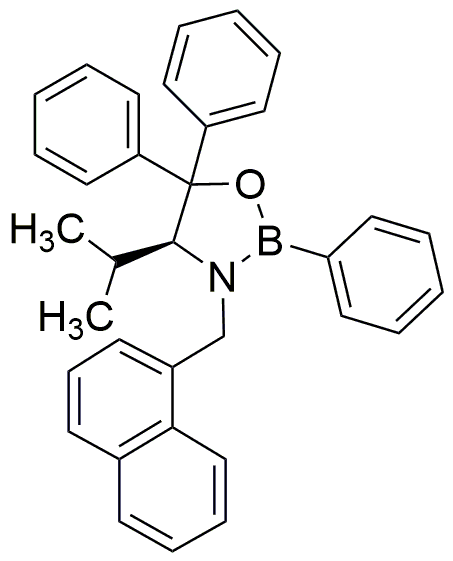(S)-4-Isopropyl-3-(1-naphthylmethyl)-2,5,5-triphenyl-1,3,2-oxazaborolidine is widely utilized in research focused on:
- Asymmetric Synthesis: This compound serves as a chiral catalyst in asymmetric synthesis, enabling the production of enantiomerically pure compounds, which is crucial in pharmaceuticals for developing effective drugs with fewer side effects.
- Organocatalysis: It is employed in organocatalytic reactions, providing a more environmentally friendly alternative to traditional metal catalysts, thus reducing toxic waste in chemical processes.
- Material Science: The compound is used in the development of advanced materials, such as polymers and nanocomposites, enhancing their properties like strength and thermal stability for applications in electronics and packaging.
- Drug Development: Its role in drug discovery includes facilitating the synthesis of complex organic molecules, which can lead to new therapeutic agents, particularly in cancer and infectious diseases.
- Research in Green Chemistry: This chemical contributes to green chemistry initiatives by enabling reactions that minimize energy consumption and reduce hazardous byproducts, aligning with sustainable practices in chemical manufacturing.
General Information
Properties
Safety and Regulations
Applications
(S)-4-Isopropyl-3-(1-naphthylmethyl)-2,5,5-triphenyl-1,3,2-oxazaborolidine is widely utilized in research focused on:
- Asymmetric Synthesis: This compound serves as a chiral catalyst in asymmetric synthesis, enabling the production of enantiomerically pure compounds, which is crucial in pharmaceuticals for developing effective drugs with fewer side effects.
- Organocatalysis: It is employed in organocatalytic reactions, providing a more environmentally friendly alternative to traditional metal catalysts, thus reducing toxic waste in chemical processes.
- Material Science: The compound is used in the development of advanced materials, such as polymers and nanocomposites, enhancing their properties like strength and thermal stability for applications in electronics and packaging.
- Drug Development: Its role in drug discovery includes facilitating the synthesis of complex organic molecules, which can lead to new therapeutic agents, particularly in cancer and infectious diseases.
- Research in Green Chemistry: This chemical contributes to green chemistry initiatives by enabling reactions that minimize energy consumption and reduce hazardous byproducts, aligning with sustainable practices in chemical manufacturing.
Documents
Safety Data Sheets (SDS)
The SDS provides comprehensive safety information on handling, storage, and disposal of the product.
Product Specification (PS)
The PS provides a comprehensive breakdown of the product’s properties, including chemical composition, physical state, purity, and storage requirements. It also details acceptable quality ranges and the product's intended applications.
Certificates of Analysis (COA)
Search for Certificates of Analysis (COA) by entering the products Lot Number. Lot and Batch Numbers can be found on a product’s label following the words ‘Lot’ or ‘Batch’.
*Catalog Number
*Lot Number
Certificates Of Origin (COO)
This COO confirms the country where the product was manufactured, and also details the materials and components used in it and whether it is derived from natural, synthetic, or other specific sources. This certificate may be required for customs, trade, and regulatory compliance.
*Catalog Number
*Lot Number
Safety Data Sheets (SDS)
The SDS provides comprehensive safety information on handling, storage, and disposal of the product.
DownloadProduct Specification (PS)
The PS provides a comprehensive breakdown of the product’s properties, including chemical composition, physical state, purity, and storage requirements. It also details acceptable quality ranges and the product's intended applications.
DownloadCertificates of Analysis (COA)
Search for Certificates of Analysis (COA) by entering the products Lot Number. Lot and Batch Numbers can be found on a product’s label following the words ‘Lot’ or ‘Batch’.
*Catalog Number
*Lot Number
Certificates Of Origin (COO)
This COO confirms the country where the product was manufactured, and also details the materials and components used in it and whether it is derived from natural, synthetic, or other specific sources. This certificate may be required for customs, trade, and regulatory compliance.


